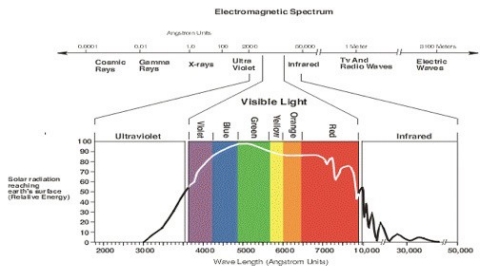Effects of Light Exposure
Visible light is a small part of the electromagnetic spectrum to which the eye is sensitive. Its presence is essential for the most rewarding perception of almost all art. Yet exposure to light can result in cumulative and permanent damage to light-sensitive objects. Low light levels over a long period of time can cause degradation equal to or even greater than intense light for a short period. Damage occurs because light is radiant energy. This energy causes irreversible change, either through radiant heating or photochemical action.
Radiant heat may cause a reaction on the surface of an object, such as cracking, lifting, and discoloration. Photochemical action is a chemical change at the molecular level and is the more profound result of light exposure. The most potent sources of these destructive energies come from just beyond the limits of visible light—ultraviolet (UV) and infrared (IR) light (fig. 1). The longer wavelength, infrared, is a common source of radiant destruction. Ultraviolet rays, with their shorter wavelength, can be a significant basis for photochemical destruction. These wavelengths should be filtered and eliminated as much as possible to prevent damage. Visible light is essential for the perception and appreciation of art, but it, too, contributes to degradation and damage of objects. Irreversible damage caused by light can include color fading, yellowing, and embrittlement. Since all damage is cumulative and irreversible, the duration and intensity of light exposure should be carefully monitored and limited.

At the National Gallery of Art we use an assortment of tools, techniques, and materials to limit and control light exposure. For monitoring we use several types of light meters that measure both foot-candles (a measure of light intensity) and microwatts per lumen (a measure of visible light emitted). We also employ several types of films and filters that significantly eliminate the UV part of the spectrum. We pay close attention to the types of illumination used for the display of art and work closely with the Gallery’s lighting department to minimize light exposure without detracting from the visual enjoyment of the art.
For additional resources and further information, including tips about caring for your own collection, please refer to the sources below.
Web Resources
American Institute for Conservation of Historic and Artistic Work
https://www.conservation-us.org/
Library of Congress
https://www.loc.gov/preservation/care/
Smithsonian Museum Conservation Institute
https://www.si.edu/mci/english/learn_more/taking_care/index.html
Canadian Conservation Institute
https://www.canada.ca/en/conservation-institute.html
Published Resources
Long, James S. Caring for Your Family Treasures. New York: Heritage Preservation and H. N. Abrams, 2000
National Committee to Save America’s Cultural Collections. Caring for Your Collections. New York: H. N. Abrams, 1992.
Rea, Mark Stanley, ed. The IESNA Lighting Handbook. New York: Illuminating Engineering Society of North America, 2000.
Conservation Division
National Gallery of Art
2000B South Club Drive
Landover, MD 20785
[email protected]